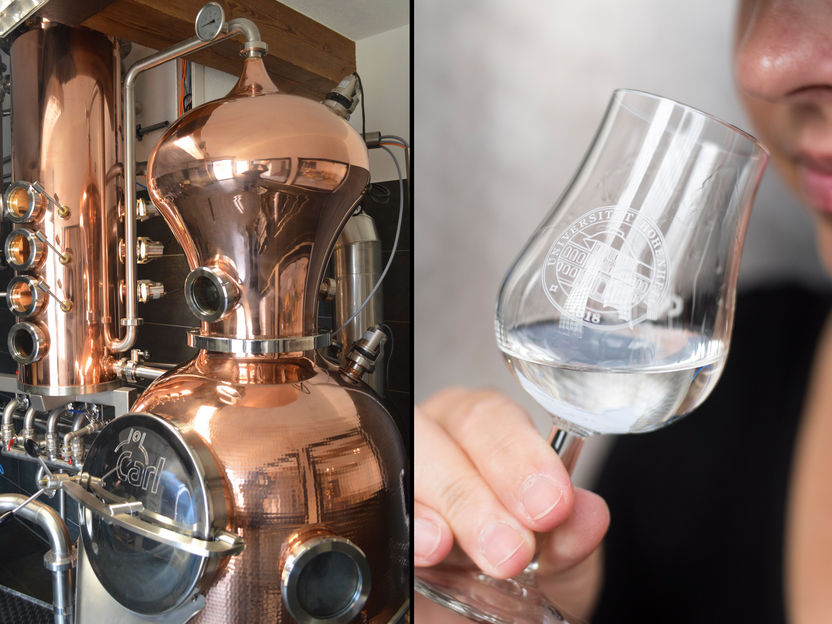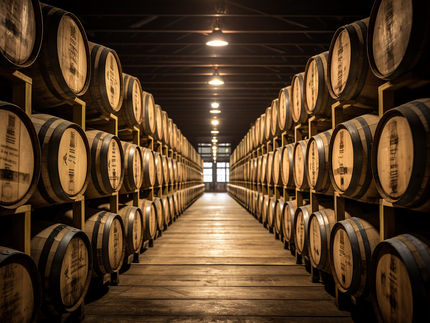Big Data for fruit brandies of consistently high quality
Digitalization allows a view into the black box, the distillation plant
Advertisement
High-quality spirits - they are essential in the fruit and small distillery in order to survive in the market. But whether the fire succeeds has so far been based only on the tact and sensitivity of the plant operators. The distillery 4.0 project is now to change this: The research and teaching distillery of the University of Hohenheim in Stuttgart had one of its Distillation plants digitalised by Carl GmbH. In this way, the researchers want to gain insight into the previously unknown processes in the plant. Their goal: practical recommendations for the approximately 14,000 small and fruit distillers in Germany.

Distillery 4.0: The research and teaching distillery at the University of Hohenheim digitises a distillation plant - for better spirits
Carl GmbH / Alexander Plank (l.) und Universität Hohenheim / Oskar Eyb (r.)
The sensory test results of the regional associations of small distillers reveal a high potential for improvement: the quality data collected every two years evaluate around 1,500 spirits each, and around 37 percent of these show noticeable quality deviations or even significant defects. This is a problem for many small burners.
"The Spirits Monopoly Law was abolished in 2018," reports Prof. Dr. Ralf Kölling-Paternoga, head of the Department of Yeast Genetics and Fermentation Technology at the University of Hohenheim. "Until then, you have been able to deliver your products - regardless of quality - at fixed prices. But now everyone has to market their products themselves. Quality is therefore becoming increasingly important for the 14,000 or so distilleries in Germany".
"The reason for quality defects is often a lack of knowledge of process engineering," explains Dr. Daniel Einfalt, head of the research and training distillery at the University of Hohenheim. When distilling spirits, he explains, the alcoholic mash is heated in the boiler. "In the subsequent distillation, alcohol is enriched in steam: Alcohol boils at 78 degrees Celsius, water only at 100, so that both can be separated in this way. The steam rises, condenses at a higher level on a so-called amplifier base. This happens on several levels - the higher, the higher the alcohol content."
At the very top there is the so-called dephlegmator in the distillation unit - a cooling unit to act on the hot alcohol vapours. Components with a high boiling point are condensed and drip back to the uppermost amplifier base. "So the distillation process is now reversed: we have a watershed, since this condenses earlier than the alcohol."
Up to now, distillation plants have been a black box
"So you can accelerate at the bottom and brake at the top," the expert summarizes the process. "When firing, we differentiate between pre-run, middle run and post-run - the middle run is used. And depending on how much throttle or brake you apply, you can shift the forward and backward motion. It changes the flavors in the product."
But there are differences of opinion as to how to ideally control this burning process. "With 10 burners there are 10 opinions," says Dr. Einfalt. The quality is therefore based exclusively on the experience and skill of the distillers - because the distillation plants have been a black box until now.
Digitalisation enables new insights
"To ensure the consistently high quality of fruit brandies, we need to gain insight into this black box - and digitalisation enables us to do so". The Hohenheim researchers have therefore had one of their copper distillation plants digitalised by the Eislingen-based company Carl GmbH for around 40,000 euros.
"Now we have ten temperature sensors on the system and possibilities for adding further sensors," explains Alexander Plank, Managing Director of Carl GmbH. " We also measure the volume flow rates of the dephlegmator reflux, the so-called phlegm, and the product. This gives us a comprehensive insight into the various material flows. Because until now nobody knew what exactly happens in the plant."
Recommendations especially for small distilleries
The researchers then examine the product for aroma components. "There are often characteristic flavouring substances, for example in the Willams Christ pear, which can then be regarded as a kind of lead substance for quality," said Dr. Einfalt about the further procedure.
"The Distillery 4.0 project is aimed primarily at small distilleries, which of course cannot have their plants digitized themselves - the technical equipment would double the price of a plant," says Dr. Einfalt. "Our aim is therefore to provide recommendations for practice on a scientific basis, which we derive from the digital data."
Most important goal: quality assurance
But the researchers are also focusing on another problem: foam formation. "In order to get a grip on foam formation, silicone oils are currently commonly used. These finally reach the fields via the stillage. We want to find natural alternatives to this, for example by means of targeted water jets."
"Ultimately, we are looking for the optimum firing process depending on the starting material," summarizes Dr. Einfalt, "for the best possible quality with optimized energy consumption.
Note: This article has been translated using a computer system without human intervention. LUMITOS offers these automatic translations to present a wider range of current news. Since this article has been translated with automatic translation, it is possible that it contains errors in vocabulary, syntax or grammar. The original article in German can be found here.
Other news from the department science
Most read news
More news from our other portals
See the theme worlds for related content
Topic world Quality assurance
In the food industry, quality assurance is about much more than safety. It's about ensuring consistent standards that meet consumers' taste, nutritional and aesthetic expectations. Using state-of-the-art analytical methods and strict protocols, Quality Assurance ensures that every product delivers on the brand's promise. From appearance and taste to texture and shelf life, Quality Assurance ensures consumers get exactly what they expect.

Topic world Quality assurance
In the food industry, quality assurance is about much more than safety. It's about ensuring consistent standards that meet consumers' taste, nutritional and aesthetic expectations. Using state-of-the-art analytical methods and strict protocols, Quality Assurance ensures that every product delivers on the brand's promise. From appearance and taste to texture and shelf life, Quality Assurance ensures consumers get exactly what they expect.



























































